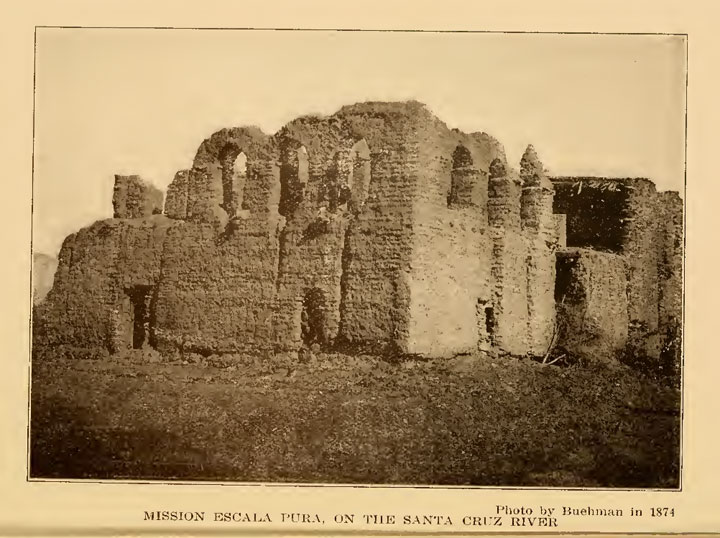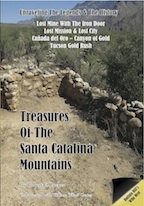Historical dates leading up to Tucson's establishment
Read "Treasures of the Santa Catalina Mountains" by Robert E. Zucker. Download a free PDF sample of the book and purchase on Amazon.com.

Photo by Estelle Buehman.
700 A.D. Hohokams
Excavations in the Tucson Downtown area
have unearthed a Hohokam Indian pithouse dated at 700 A.D. They settled
throughout the Arizona area eas early as 300 B.C. The Hohokam dug a 150
mile canal system along the Gila and Salt Rivers. The canals were used
in th 1870's by the white settlers. The Hohokam abandoned their villages
in the 15th Century for an unknown reason.
1500s Spanish Explorers
In 1540, Captain-General Francisco Coronado
was dispatched to find "the seven cities of Cibola." Coronado marched
through the area, about 25 miles from the Tanque Verde Guest Ranch.
1694 Father Kino
Father Eusebio
Francisco Kino, a Jesuit priest, visited the Indian villages in 1694. He
introduced livestock, fruits and grains from Europe. He established
several misions throughout the southwest. Colonists build settlements
around each mission. Read more about:
1751 Rebellion
The repressive Spaniard priests and soldiers
forced the Apache Indians living in the area to rebel. They killed all
the Spaniards and plundered the outposts. The first Spanish post was
established in 1752 in Tubac. Read more about Tucson's history in the 1700s.
1880s Mining Boom
The Santa Catalina Mountains
became valued for its precious metals in the late 1800s through the mid
1940s. After the Gadsden Purchase, Americans began to flood the
Southwest United States in search of gold, silver and copper. This
period of mining brought thousands of people to live and work throughout
the Catalina Mountains from Mt. Lemmon to Oracle. Such notables as W.F. "Buffalo Bill" Cody owned extensive mining claims in the back hills.
The Mine with the Iron Door
is the legend of the lost Escalante mine that supposedly contains gold
mined by the Pima Indians under the Jesuits occupancy. The Iron Door
Mine was sealed up and its location is lost on history. But, the mine
legend is still alive.
Read more about:
Local Tucson History Books
These books are written by local author and publisher Robert Zucker. Read chapters and download a free PDFs from the books and purchase full copies on Amazon.com.
 Entertaining Tucson Across the Decades
is a collection of hundreds of interviews with local entertainer and
musicians, newspaper articles and original photographs covering 50 years
of Tucson music and arts entertainment from 1950-1999. Entertaining
Tucson is a 3-volume set with over 700 pages of historical entertainment
coverage.
Entertaining Tucson Across the Decades
is a collection of hundreds of interviews with local entertainer and
musicians, newspaper articles and original photographs covering 50 years
of Tucson music and arts entertainment from 1950-1999. Entertaining
Tucson is a 3-volume set with over 700 pages of historical entertainment
coverage.
 Treasures of the Santa Catalina Mountains
is one of the most comprehensive books written on the legends and
history of the Catalina mountains, north of Tucson. Learn about the Iron
Door mIne, Buffalo Bill Cody's mining interest in the Catalinas and how
the lure of gold brought prospectors to the Cañada del Oro– the Canyon
of Gold. The story of the the lost mine, the lost city and the lost
mission.
Treasures of the Santa Catalina Mountains
is one of the most comprehensive books written on the legends and
history of the Catalina mountains, north of Tucson. Learn about the Iron
Door mIne, Buffalo Bill Cody's mining interest in the Catalinas and how
the lure of gold brought prospectors to the Cañada del Oro– the Canyon
of Gold. The story of the the lost mine, the lost city and the lost
mission.
Tucson Gold Rush 1880 In
the 1880s explores the history of numerous mining claims that were
staked throughout the Santa Catalinas and nearby mountains by local
pioneer businessmen, many reclaiming old abandoned Spanish and Mexico
diggings.
© 2011-2019. EMOL.org / Entertainment Magazine On Line. All rights reserved.